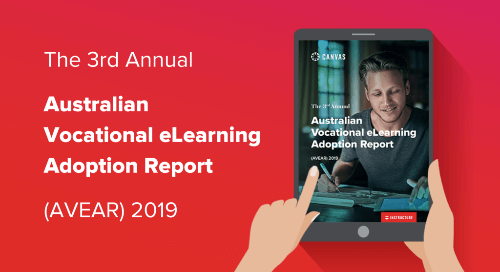A new report on the adoption and use of online learning systems, tools and applications within the vocational education and training (VET) sector provides valuable insight into eLearning adoption.
The recently-released 3rd Annual Australian Vocational eLearning Adoption Report '(AVEAR) 2019', surveyed 159 vocational professionals on eLearning usage and trends in the Australian VET sector. The report (now in its third year) collected data from contributors in November/December 2019 (prior to the COVID-19 outbreak) and looks into subjects such as the drivers for eLearning, user experience, video usage and blended learning.
A panel, comprised of VETNexus’ Kerri Buttery, MRWED’s Damian Noud and Instructure’s own Tori Carroll and Adam Ware, (recorded here) dug into the report and considered it in light of the changes that COVID-19 imposed. Their discussion dissects the data captured in the report, provides insight into the present environment and ruminates on the future of e-Learning (that may continue to include less face-to-face contact).
The report itself delves into these subjects:
- Blend of Online and Traditional Learning Methods
- Maturity and Extent of Use
- Integration with SMS or SIS
- Additional eLearning Tools and Applications
- Changes in Course Completion Rates and Student Satisfaction
- Expected Growth in eLearning Use
- Functions Enabled by eLearning
- Drivers and Importance of eLearning
- Use of Video
- Use of Online Learning Resources
Three of the key themes detailed in the report and discussed in the webinar are:
- Drivers for eLearning
- Barriers to Adopting Online Learning
- Video Usage
- Main driver for online learning: student demand
- The biggest reported drivers for using online learning were to meet student demand and to increase student engagement.
Both of these drivers had grown in importance since the 2018 survey. Meeting student demand was a top driver (52% in 2019 up from 42% in 2018) and increasing student engagement was also an important driver (47% up from 44% in 2018).
“It’s interesting to see that there was significant student appetite for online learning even before COVID,” said Tori Carroll, Customer Success Manager at Instructure in the webinar when discussing the findings.
And even before COVID-19, the survey showed that 74% were expecting to increase their online learning in the next two years; a figure that may ramp-up post-pandemic.
Management preference tops the cited barriers to online learning
The main reason cited this year for not providing online learning (to the tune of 36%) was “management preference for face-to-face teaching”. This had risen from 30% the year before.
Surprisingly, “students’ lack of IT skills” (24%) came up as a major reason for not providing online learning this year (it hadn’t been included as a response in previous surveys). In answering the same question the possibility of low student engagement resonated to the tune of 15% and a lack of student appetite was 6%.
It would be fascinating to see whether these and the other barriers present themselves as major challenges to the adoption of online learning going forward, given the position we all found ourselves in shortly after these results were captured.
Video is being embraced
While video usage has obviously taken off since social distancing, the report showed the medium was already being embraced prior to lockdown by 75% of respondents: 24% within their learning management system, 38% linking to content on public and private channels from external resources, and 13% using their own separate content management system.
For those that weren’t using video, the two main reasons identified were the availability of good technology (37%) and the belief that teachers were not comfortable being in front of the camera or creating videos themselves (also 37%).
“We hear all the time about people not wanting to present or be in front of a video,” said Ms Carroll. “Having a go is the first step; nothing needs to be perfect and in fact, no students want to watch a robot. Letting your personality come out is great for collaboration and building trust and rapport with students,” she added. She also said organisations should think about having a mixture of more ad-hoc videos which connect with students and video learning content that can be used year after year to improve efficiency.
The report's findings (including student-centric top drivers to online learning) are expected to be welcome news to RTOs. This particularly applies to RTOs who have been compelled to increase the amount of online teaching they offer due to social distancing, as well as those that have already been embracing online learning.
Another hopeful takeaway when we look at the comparative changes year-on-year is that the vocational space (including its organisations and professionals) is consistently evolving. The changes to the various aspects of eLearning adoption as described in the report, over the past three years could be seen as a positive example of the VET sector’s agility and ability to adapt.
This report was a joint project between Instructure Australia and Velg Training, Australia’s leading provider of Vocational Education and Training.
The full AVEAR report is available to download here.
The webinar quoted above is available to watch here.
Keep Learning,
The Canvas Team
Related Content
 the_five_essentials_for_vocational_learning_platforms.png
the_five_essentials_for_vocational_learning_platforms.pngBlogs
 signs_its_time_to_rethink_your_learning_platform.png
signs_its_time_to_rethink_your_learning_platform.pngBlogs
 from_admin_tool_to_growth_driver.png
from_admin_tool_to_growth_driver.pngBlogs

